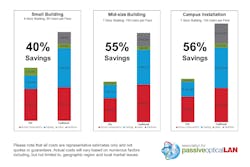APOLAN claims passive optical LAN trims costs 56% over traditional enterprise networks
The Association for Passive Optical LAN (APOLAN) announced the results of it Passive Optical LAN Cost Comparison study, conducted to illustrate the possible economic advantages of POL over traditional enterprise networks based on Category cable.
The study was developed by the APOLAN Technology Committee, a diverse group of industry experts from numerous companies to provide technical analysis and data to the marketplace.
Per the APOLAN study's summary findings:
By deploying POL, network architecture is simplified, enabling end users to take advantage of added reliability and virtually unlimited bandwidth. In addition to these important benefits, the POL cost comparison study confirmed that when compared to traditional structured cabling:
-- POL saves 40 percent cost for a 4-story building with 90 users per floor
-- POL saves 55 percent cost for a 7-story building with 150 users per floor
-- POL saves 56 percent cost for the four 6-story campus buildings with 180 users per floor
“Not only is POL the most bandwidth efficient and reliable architecture to deliver tremendous improvements in the design and deployment of local area networks, it also continues to prove measurable capex and opex savings,” contends Matt Miller, AECOM Technology Solutions Networks Leader and APOLAN Chairman.
Miller adds, “APOLAN’s cost comparison study reaffirms what we have known for some time now – Passive Optical LAN delivers the significant investment protection, along with its technological superiority.”
APOLAN says the study found that POL’s lower costs are primarily a result of:
- Centralizing intelligence and management, enabling lower maintenance requirements.
- Removing telecommunications rooms (i.e. IDFs, wiring closets), allowing for the conversion of the extra space to more revenue-generating areas.
- Reducing midspan electronics, power, and cooling infrastructure, resulting in lower energy and cooling costs.
- Eliminating expensive hardware network equipment typically required in traditional copper-based networks.
- Smaller, lighter, less expensive cables to reduce pathway and space requirements.
- Not needing to refresh cabling infrastructures – POL limits the need, and associated expenses, for continuous network upgrades.
For the study, the APOLAN Technology Committee, the group of industry leaders and networking experts that spearheaded the research, analyzed the cost of POL parameters (e.g. 4-port PoE ONTs, ONTs shared in cubicles, 2×32 splitters, zone box solution and no TRs) versus those of traditional parameters (e.g. 48-port PoE switches, one 10G uplink per TR, stacked switches and (2) Cat 6 drops per user).
The comparison was then built out to represent one 4-story building with 90 users per floor, one 7-story building with 150 users per floor, and four 6-story campus buildings with 180 users per floor. (All costs in the study are representative estimates only and not quotes or guarantees; APOLAN concedes that actual costs will vary based on numerous factors including, but not limited to, geographic region and local market issues.)
